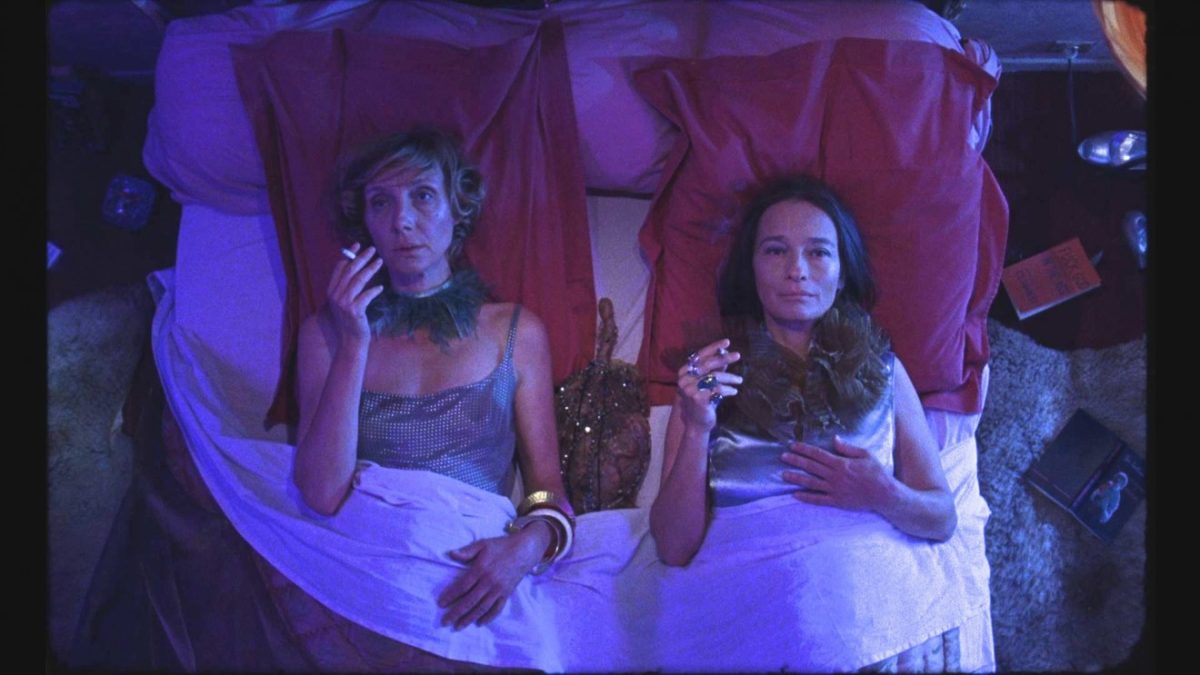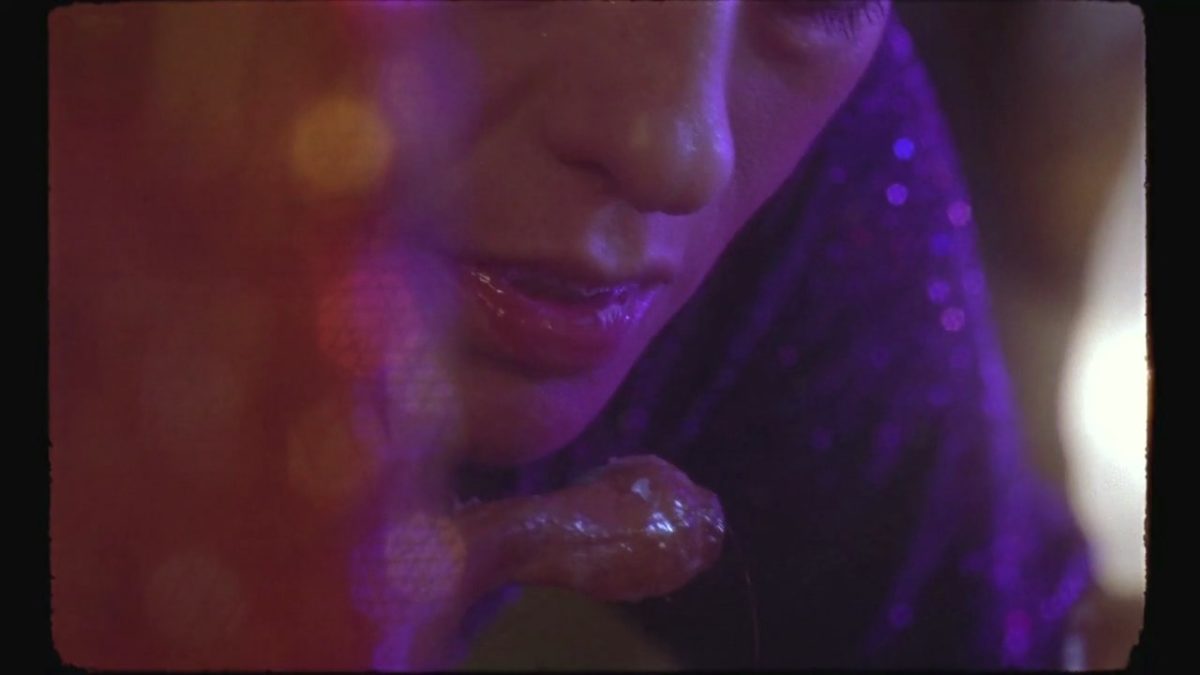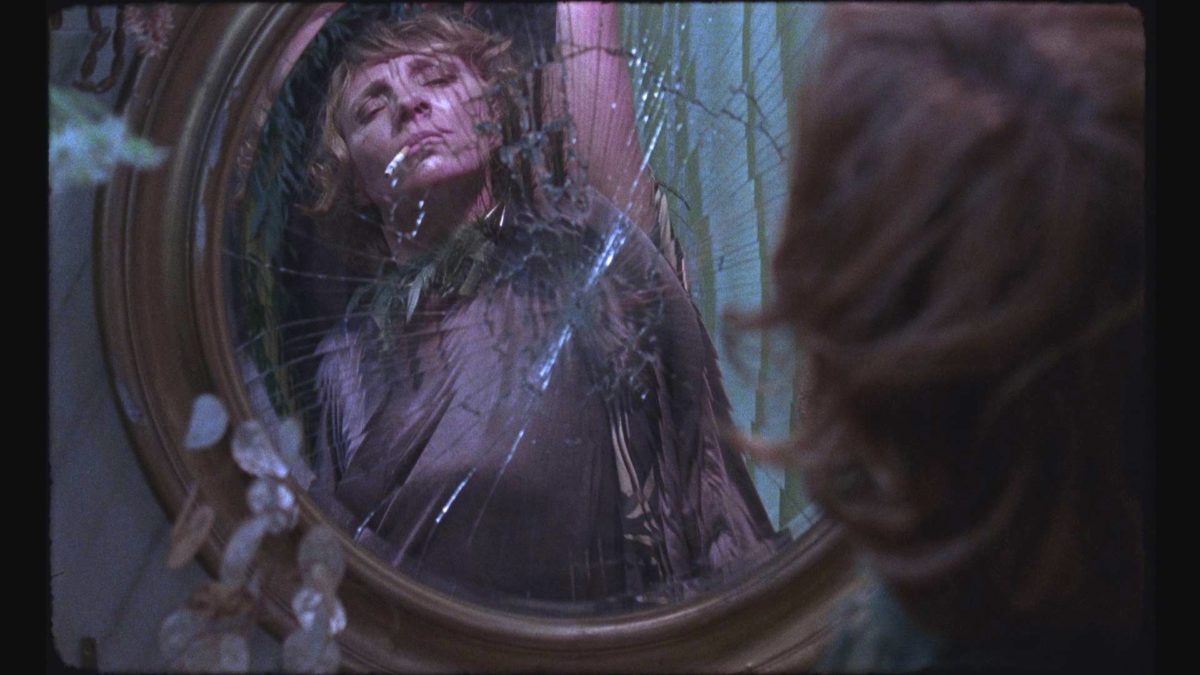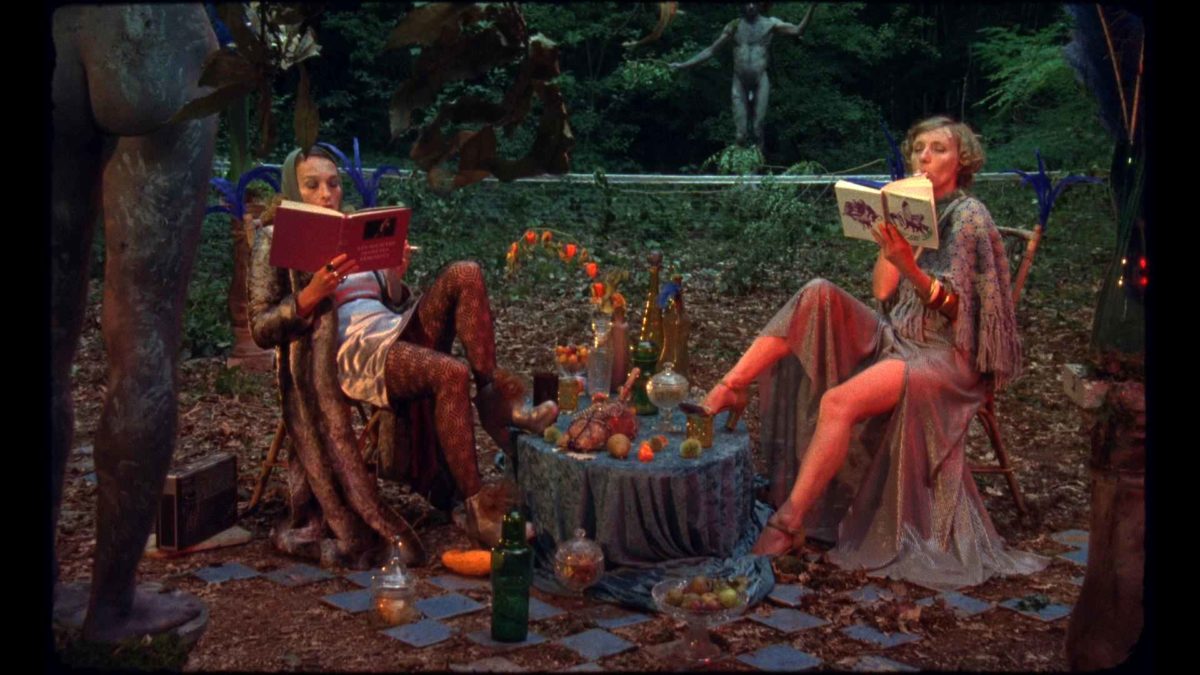The French filmmaker Bertrand Mandico, arguably the unacknowledged love child of Walerian Borowczyk, Kenneth Anger and Jean Cocteau, has made about 30 short films, a few advertisements, and one feature film. From hysterical animated commercials in the vain of the Quai Brothers and Jan Švankmajer to hyper colorful baroque-y fever dreams with a perverse nymphomaniac touch, his films seem to cross the borders of decency and break down conventional binaries between organisms.
His 30-minute live-action short Notre-Dame des Hormones (2015), for instance, features two actresses in their “artistic menopause”; Lune (Elina Löwensohn) and Lautre (Nathalie Richard), roughly translated as ‘Theone’ and ‘Theother’, both in their early fifties. While rehearsing for a play, they stumble upon something so attractive it will determine the course of their lives (and, subsequently, deaths). The object of their desire: a living, hairy chunk of flesh with a penis-shaped ‘antenna’. La Chose (or, The Thing) is not the only smutty appearance in Mandico’s twisted parallel universe: a deer has human-like breasts, slimy horny plants like to get spanked, and a fair amount of naked people try their best to interpret their roles as static statues as well as possible.
His nightmarish sex fairy tales often display a bodily in-between-ism that is as alluring as it is perverse. His films transgress gender norms and the laws of nature, often depicting creatures that are neither one thing nor another, compressing two divergent characteristics in one body. Those fluid identities are always a sort of mixture of components, a collage. Inanimate objects are anthropomorphized in the most lascivious way possible, like the very fuckable bushes and the phallic liquid dispensers at the hedonist island in Les garçons sauvages (2017) (so far Mandico’s only feature film), inspired by Michel Tournier’s Robinson-Crusoe-adaptation Vendredi ou les limbes du Pacifique (1967).
In the last few years, the (often rather hairy and fleshy) disturbingly sexy object-creatures seem to have become Mandico’s trademark. La Chose is no exception, lingering somewhere between a dead piece of meat and a living, breathing, feeling, thinking being. It sparks an intense fetishist craving in the actresses, resulting in a quarrel about who can lick it. The obsessive, experimenting interest in La Chose recalls theatrical celebrations of monstrous bodies across different time periods. From ancient myths about humanoid beasts to (relatively) more recent performative events like carnival freak shows, grand guignol and the anatomical theaters: art and science have been historically intertwined in the portrayal of everything bizarre, enabling people to laugh at, examine and dissect the weird and the mad.
Mythological and psychoanalytical references appear extensively in Mandico’s work, which is heavily inspired by urban legends, fairy tales and oral tradition. Hybrid, often intersex creatures have been around the block for a while, and remind of age-old belief systems, like Proto-Indo-European mythology, where divinity and monstrosity were no mutually exclusive concepts. In ancient Greek and Roman history, beings like Medusa and Hydra had the aura of holy entities, and hermaphrodites were worshipped like gods. Mandico himself (in an interview with Martin Kudlac for online magazine ScreenAnarchy) refers to art history, explaining that his “re-appropriations of bodies echo certain ancient or modern paintings and sculptures that feed […] [him], from Max Ernst to the Chapman brothers.”
However, monsters in pop culture are often portrayed as drooling and scary instead of divine atrocities. In an interview with French magazine Trois Couleurs, Mandico indicated that he wanted to create a new role, a new narrative for those creatures:
Les freaks évoluent dans une société aseptisée qui fait tout pour se débarrasser d’eux… Il faut qu’on fasse revenir les monstres, mais autrement. En les magnifiant. […] Le monstre, c’est une nouvelle chair en mutation qui permet d’imaginer de nouveaux orifices, de nouveaux pénis, plein de nouveaux organes. Ça promet plus de possibles dans le Plaisir. [The freaks reside in a sanitized society that does everything to get rid of them … We have to bring the monsters back, but otherwise. By magnifying them. […] The monster is a new flesh in mutation that makes it possible to imagine new orifices, new penises, lots of new organs. It promises more Pleasure-related possibilities.]
One of those brand new penises is La Chose’s main attraction; Mandico captures the gross transgressive quality of The Thing, all the more enhancing its attractiveness. It is, despite or thanks to its biological atypicality, the centerpiece of attention, and finds itself often literally in middle of the screen, right in between the two actresses. La Chose has become a religion to them. They call it Notre-Dame des Hormones (Our Lady of Hormones) and divinize it accordingly. This is a great illustration of Mandico’s transcending gender dynamics: while La Chose clearly has a phallic shape, the actresses assign it a female role, one that refers to the Virgin Mary, the iconic mother. Aside from the fact that La Chose is probably more on the streetwalker side of the conventional female whore-Madonna-spectrum, it turns out that it is the mother of the mud-covered Oedipus (Michel Lebayon) who appeared at the beginning of the film; opening up a psychoanalytic can of worms.
Within the diegeses of the film, Mandico makes a more specific statement about sex and religion. Right after the threesome between Lune, Lautre and La Chose, Ed Sanders’ book Fuck God in The Ass is lying on the floor, clearly visible. Obscene counterculture poetry, possibly perversely doubled as an instruction manual. Anyway, like Fuck God, Notre-Dame is a middle finger to the establishment.

The actresses themselves seem to be part of a twisted, immoral beau monde, obsessed with sex and treason. Their fashion sense floats somewhere between Grey Gardens’ Little Edie (1975) and the moon goddess from Jacques Rivette’s Duelle (1976). Their character traits are just as peculiar and excessive, altering between a more natural and an ultra-stylized, dramatic ways of performing. Inscribing itself in a film history of camp 50-something female dyads and lone wolfs, Notre-Dame des Hormones builds on works like What Ever Happened to Baby Jane? (Robert Aldrich, 1962), Femmes Femmes (Paul Vecchiali, 1974), Die Sehnsucht der Veronika Voss (Rainer Werner Fassbinder, 1982) and Sunset Boulevard (Billy Wilder, 1950). The near-geriatric, histrionic female leads are, like the characters they embody and the films they star in, quintessentially and canonically camp. Equivalent to Bette Davis and Joan Crawford in Baby Jane or Gloria Swanson in Sunset Boulevard, Lune and Lautre embody — through over-the-top aesthetics — something like a former glory; the twilight of their lives and careers. In their own words: “Perhaps you are already at the cemetery of forgotten actresses, but you don’t realize it”.
Mandico’s cinema might be one of the most radical examples of contemporary camp, de-naturalizing the now commodified extraordinariness that once — in the bygone days of good ol’ gay camp — was the arena of art deco, ambiguous stars like Davis or Crawford, and John Waters movies. That is, if you agree with the points underground artist Bruce Labruce made in his essay ‘Notes on Camp/Anti Camp’ (2012). In that text, Labruce draws the line between Classic Gay Camp (e.g. George Kuchar, The Catholic Church, Mae West), Bad Gay Camp (e.g. Lady Gaga, Contemporary Broadway Musicals, Neil Patrick Harris), Good Straight Camp (only a few Woody Allen, Robert Altman and John Cassavetes films), Bad Straight Camp (e.g. Star Wars, Baz Luhrmann, Jeff Koons) and many other subcategories. Labruce argues that camp nowadays is appropriated by the masses, and even dethroned ‘ordinary’ irony in pop culture. In his words: “the whole goddamn world is camp.” Merely having a transgressive subject matter isn’t even anti-Hollywood anymore. Camp became a commodity fetish and a normalized practice; an empty, often heterosexualized pastiche, marked by detached and decontextualized aesthetics, reducing the camp sensibility to “the ideological white noise of the new millennium”.
Mandico, however, receives points for authenticity by preserving a DIY-vibe inherently linked to the queer cinema of the Kuchar brothers and their successors (e.g. John Waters), channelling a hysterical aestheticism, a love for anything artificial, an aversion for anything serious, and intentionally bad taste. His films capture the joy of movement (and bodily fluids) in ludicrous décors and portray filth without forgetting its history. Mandico’s signature flamboyance seamlessly connects with the work of his sources of inspiration; his films are equally (or even more so) unapologetically gender bending, although re-contextualized. The queer utopia, resurrected from the grave. Mandico dares to displease, to challenge, to go against the grain; as if he responded to the motivational talk Pope of Trash John Waters gave to the graduates of the Rhode Island School of Design:
Contemporary art’s job is to wreck what came before. […] Design clothes so hideous that they can’t be worn ironically. Horrify us with new ideas. Outrage outdated critics. Use technology for transgression, not lazy social living. Make me nervous! […] It’s your turn to make trouble.

Together with Icelandic filmmaker and producer Katrin Olafsdottir, Bertrand Mandico composed a “flamboyant surge, not a dogma”: the Incoherence Manifesto (2018), in which they claim that to have faith in cinema means “to have a romantic approach, unformatted, free, disturbed and dreamlike, cinegenic, an epic narration. Incoherence that’s an absence of cynicism but not irony. It’s embracing the genre without penetrating it”:
- Rejection of any rule of screenplay. / Screenplay Incoherence
- The sound will be created in post production. / Manufacturing Incoherence
- Filming must be done on expired film stock. / Sophistication Incoherence
- Special effects must be made in-camera (overprint, projections etc). Banish post-production. / Effects Incoherence
- Use of optical effects in-camera (filters etc). / Style Incoherence
- The film must be in an uncertain geography, timeless, ban any realistic effect. / Time and geography Incoherence
- The material for the sets (scenery, costume and props) must come from found material. / Taste Incoherence
- Films must be hybrids containing at least two genres. / Style Incoherence
- The film used can be 16mm, 35mm, Super 8mm. /Economic Incoherence
- The director must be the author, cameraman and art director of the film. / Creative Incoherence
- Actors will alternate non acting and overacting. / Acting Incoherence
- The film does not belong to any aesthetic or narrative tendency. It must have a deep and fragile cinematography / Cinematographic Incoherence
A few months ago, Mandico published (in collaboration with Caroline Poggi, Jonathan Vinel and Yann Gonzalez) another manifesto in Cahiers du Cinéma: ‘Flamme’. There, the filmmakers make a plea for intersectionality and a fiery cinema, “un cinema pour les rêveurs transpirants, les monstres qui pleurent et les enfants qui brûlent.” [“A cinema for sweaty dreamers, crying monsters and burning children.”] They invite everyone to blow on the embers, to desire, to create beyond installed hierarchies of things, to traverse beyond the screen, the spirit, the actors, fear and joy. Again, like with the Incoherence Manifesto: “Ce n’est pas un dogme, juste une Flamme dans la nuit, notre état du moment.” [“It’s not a dogma, just a flame in the night, our state of the moment.”]
Remarkably enough, the filmmaker devoted himself to the short form for over twenty years, until last year, when his first feature Les garçons sauvage (2017) hit the festivals. The manifestos might explain why: the 47-year-old filmmaker seems to be captivated by a cinephiliac Peter Pan Syndrome, clinging willfully to some sort of adolescence, a formal and narrative rebelliousness that traditionally is the playground for teenagers and twentysomethings. Mandico doesn’t care about or is averse to the capitalist circus that is the film industry, resulting in his staying away from feature length. Furthermore, his films, heavily influenced by literature, often operate like optical poems, with a meticulously composed rhythm, attention to detail and a visual atmosphere that differs slightly from film to film. This poetic inclination could also explain Mandico’s devotion to brevity.
In his practice, Mandico playfully opposes both everything mainstream cinema stands for, as well as dull socio-realist festival films. In the interview with Martin Kudlac, he made his point extra clear:
We collapse on naturalism and reality. Surveillance videos, homemade family video, reports, documentaries, YouTube videos, fictions. Realism devours everything, imagination is put away into a closet. We are leaving the opportunity to invest into imagination and to compartmentalize it into flashy aesthetic conventions to Hollywood. I consider important to invest into fantasy and imagination attempting to give it different angles of aesthetic approach and narratives.
The manifestos express a passionate love for cinema and a move in the opposite direction from the conventional. They denounce categories, celebrate the out of the ordinary and reject any type of coherence. The result: eclectic films that lack conventional narrative or overused practices, and a more unique body of work. This way, while he relies on techniques that are associated with a bygone era, like the creation of post-production sound, the use of (expired) film stock and in-camera special effects, Mandico’s films feel contemporary and vibrant. As an active despiser of fake vintage and nostalgic reconstructions, he seeks new ground in combining different historical or found elements into one, fictional place. Notre-Dame des Hormones, shot on 16 mm, is otherworldly. It seems to exist outside of time and space, in a grotesque parallel universe, an ultra-perverse Garden of Eden. The décors, in all their theatricality, live and breathe the baroque idea of horror vacui, bathing in colorful lights that channel something like if Kenneth Anger toned slightly down on the psychedelic drugs and had even more fog machines at his disposal. Decadent faux-chic thrift shop ornaments clutter up tables in aesthetically pleasing compositions. Flora is everywhere, from the lustful flowers to scattered fruits (even though the women don’t really look like healthy snackers). The actresses excessively bejewel the furry drab of meat that is La Chose, making it look like a self-proclaimed rapper, or a 14-year-old at Claire’s.
Mandico’s style thus seems, like the portrayed bodies, a hybrid in itself, a liminal space, maybe. The creepy, enigmatic aura of his work is inspired by Tod Browning, Luis Buñuel and David Lynch, the magic by Cocteau and Rivette. He borrows from Walerian Borowczyk’s surrealism, which is, according to Mandico himself, “cruel and tender. Like a needle in a peach.” But while he preaches incoherence, Mandico is anything but a disjointed assemblage of his sources of inspiration. The magical atmosphere is more robust than Cocteau’s, and less connected to everyday life than Rivette’s. The mystery is less misanthropic than Buñuel’s and Lynch’s, and the sensual narrative build-up is less gratuitous than Borowczyk’s basic porno-plots. Furthermore, his compositions are meticulously thought-through; he has an eye for symmetry, and his devotion to his trademark colour palette is unparalleled.
Notre-Dame’s monstrous, theatrical bodies on screen are right at home ,in a twisted sex nightmare that is as captivating as it is disgusting. The eclectic incoherence of the film’s form resonates with the uncategorizability of bodies and things, floating somewhere in a no man’s land of meaning. Even the characters’ names reflect this: Lune, Lautre and La Chose are just vague references that indicate the inability to pinpoint something significant. Mandico’s films, however, are anything but random. He recycles techniques, genres, and sensibilities from the past, but approaches them from a new angle. His creations testify to a highly stylized practice and shed a contemporary but authentic light on camp aesthetics. Dripping with sweat, sperm and imagination, Notre-Dame’s perverse Paradise on Earth leaves a wonderfully gross aftertaste.

